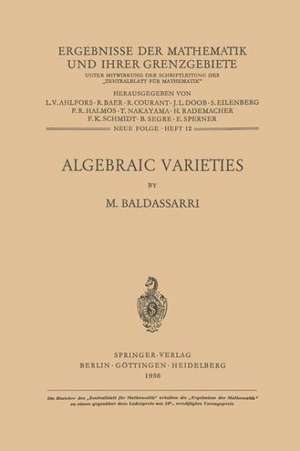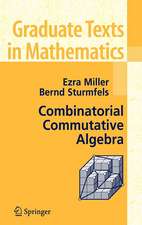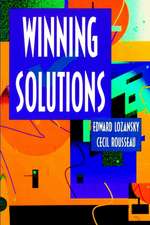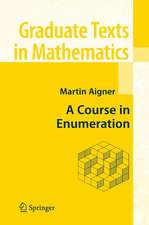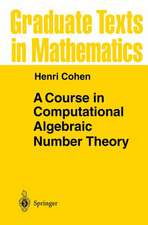Algebraic Varieties: ERGEBNISSE DER MATHEMATIK UND IHRER GRENZGEBIETE 2 FOLGE, cartea 12
Autor M. Baldassarrien Limba Engleză Paperback – 21 iul 2012
Din seria ERGEBNISSE DER MATHEMATIK UND IHRER GRENZGEBIETE 2 FOLGE
-
 Preț: 442.02 lei
Preț: 442.02 lei -
 Preț: 409.43 lei
Preț: 409.43 lei -
 Preț: 484.47 lei
Preț: 484.47 lei -
 Preț: 376.96 lei
Preț: 376.96 lei -
 Preț: 491.72 lei
Preț: 491.72 lei - 15%
 Preț: 704.04 lei
Preț: 704.04 lei -
 Preț: 345.71 lei
Preț: 345.71 lei -
 Preț: 382.95 lei
Preț: 382.95 lei - 15%
 Preț: 636.45 lei
Preț: 636.45 lei -
 Preț: 489.87 lei
Preț: 489.87 lei -
 Preț: 387.75 lei
Preț: 387.75 lei - 15%
 Preț: 493.56 lei
Preț: 493.56 lei -
 Preț: 393.35 lei
Preț: 393.35 lei -
 Preț: 377.95 lei
Preț: 377.95 lei -
 Preț: 384.31 lei
Preț: 384.31 lei -
 Preț: 413.07 lei
Preț: 413.07 lei -
 Preț: 380.25 lei
Preț: 380.25 lei -
 Preț: 412.68 lei
Preț: 412.68 lei -
 Preț: 385.62 lei
Preț: 385.62 lei -
 Preț: 415.39 lei
Preț: 415.39 lei -
 Preț: 376.59 lei
Preț: 376.59 lei -
 Preț: 379.48 lei
Preț: 379.48 lei -
 Preț: 483.27 lei
Preț: 483.27 lei -
 Preț: 414.42 lei
Preț: 414.42 lei - 15%
 Preț: 579.67 lei
Preț: 579.67 lei - 15%
 Preț: 636.63 lei
Preț: 636.63 lei -
 Preț: 419.06 lei
Preț: 419.06 lei - 18%
 Preț: 1108.67 lei
Preț: 1108.67 lei - 15%
 Preț: 578.37 lei
Preț: 578.37 lei -
 Preț: 381.43 lei
Preț: 381.43 lei -
 Preț: 383.12 lei
Preț: 383.12 lei -
 Preț: 375.45 lei
Preț: 375.45 lei -
 Preț: 171.74 lei
Preț: 171.74 lei -
 Preț: 150.03 lei
Preț: 150.03 lei -
 Preț: 381.00 lei
Preț: 381.00 lei -
 Preț: 413.27 lei
Preț: 413.27 lei -
 Preț: 410.17 lei
Preț: 410.17 lei -
 Preț: 381.21 lei
Preț: 381.21 lei -
 Preț: 383.12 lei
Preț: 383.12 lei -
 Preț: 480.83 lei
Preț: 480.83 lei -
 Preț: 375.62 lei
Preț: 375.62 lei -
 Preț: 382.36 lei
Preț: 382.36 lei -
 Preț: 383.50 lei
Preț: 383.50 lei -
 Preț: 181.74 lei
Preț: 181.74 lei -
 Preț: 408.77 lei
Preț: 408.77 lei -
 Preț: 359.54 lei
Preț: 359.54 lei -
 Preț: 376.43 lei
Preț: 376.43 lei
Preț: 383.12 lei
Nou
Puncte Express: 575
Preț estimativ în valută:
73.31€ • 78.39$ • 61.12£
73.31€ • 78.39$ • 61.12£
Carte tipărită la comandă
Livrare economică 18 aprilie-02 mai
Preluare comenzi: 021 569.72.76
Specificații
ISBN-13: 9783642527630
ISBN-10: 3642527639
Pagini: 208
Ilustrații: XII, 196 p.
Dimensiuni: 155 x 235 x 11 mm
Greutate: 0.3 kg
Ediția:1956
Editura: Springer Berlin, Heidelberg
Colecția Springer
Seria ERGEBNISSE DER MATHEMATIK UND IHRER GRENZGEBIETE 2 FOLGE
Locul publicării:Berlin, Heidelberg, Germany
ISBN-10: 3642527639
Pagini: 208
Ilustrații: XII, 196 p.
Dimensiuni: 155 x 235 x 11 mm
Greutate: 0.3 kg
Ediția:1956
Editura: Springer Berlin, Heidelberg
Colecția Springer
Seria ERGEBNISSE DER MATHEMATIK UND IHRER GRENZGEBIETE 2 FOLGE
Locul publicării:Berlin, Heidelberg, Germany
Public țintă
ResearchCuprins
I. A survey of the foundations.- 1. Algebraic varieties.- 2. Absolute and relative varieties.- 3. The local rings.- 4. Algebraic product.- 5. Normal varieties.- 6. Birational transformations.- 7. Simple points.- 8. The intersection multiplicity.- 9. The calculus of cycles.- II. The resolution of singularities.- 1. The local uniformisation theorem.- 2. Monoidal transformations.- 3. Zariski’s proof for threefolds.- III. Linear systems.- 1. Divisors.- 2. The definition of linear system.- 3. Linear equivalence.- 4. Complete systems.- 5. The multiples of a linear system.- 6. Ample linear systems.- 7. Bertini’s theorems.- IV. The geometric genus.- 1. The adjoint forms.- 2. The canonical system.- 3. The canonical system as a birational invariant.- 4. The arithmetic definition of the canonical system.- 5. Relations between canonical and adjoint systems.- V. The arithmetic genus.- 1. The definition.- 2. The modular property of the arithmetic genus.- 3. The definition of the virtual arithmetic genus of a cycle.- 4. The birational invariance of the arithmetic virtual genus.- 5. The absolute invariance of pa(V) (r ? 3).- 6. The virtual characters of a cycle.- 7. Virtual and effective dimensions.- 8. A second definition of the arithmetic genus.- 9. The virtual characters of K.- VI. Algebraic and rational equivalence.- 1. The associated variety.- 2. Specialisation of a cycle and algebraic systems.- 3. Algebraic correspondences.- 4. The degeneration principle of Enriques-Zariski.- 5. Fundamental and exceptional varieties.- 6. A property of Chow varieties.- 7. Algebraic equivalence.- 8. Rational equivalence.- 9. The intersection-product for equivalence classes.- 10. A theorem of Severi and its consequences.- VII. The Abelian varieties from the algebraic viewpoint, and relatedquestions.- 1. Jacobi variety.- 2. The base for the group of algebraic equivalence for divisors.- 3. The first Picard variety.- 4. The total maximal algebraic families.- 5. A property of the arithmetic genus.- 6. Non-special total families.- 7. The first Picard variety according to Matsusaka.- 8. The second Picard variety and the superficial irregularity.- VIII. Theory and applications of the canonical systems.- 1. Introduction.- 2. A new definition of the canonical divisors.- 3. Todd’s canonical systems.- 4. Introduction to Segre’s theory.- 5. The covariant sequence.- 6. The algebra of covariant sequences.- 7. The canonical sequence.- 8. Some applications.- 9. The behaviour of the canonical systems under birational transformations.- 10. Irregular intersection problems.- 11. Miscellaneous results.- IX. The algebraic varieties as complex-analytic manifolds.- 1. The complex manifolds and Chow’s theorem.- 2. Hermìte’s and Kähler’s metrics.- 3. The currents.- 4. The fundamental existence theorems.- 5. The complex operators.- 6. The Hodge-Eckmann theory.- 7. Hodge’s birational invariants.- 8. Miscellaneous results.- 9. Chern’s classes as canonical classes.- X. The applications of stack theory to algebraic geometry.- 1. Complex line bundles.- 2. The stack concept.- 3. Cohomology groups over a stack.- 4. A theorem of Dolbeault.- 5. Positive complex line bundles.- 6. The Picard variety in stack theory.- 7. The theorem of Riemann-Roch for adjoint systems.- 8. The arithmetic genera.- 9. The Riemann-Roch theorem.- 10. Miscellaneous results.- XI. The superficial irregularity and continuous systems.- 1. The deficiency of a linear system.- 2. The Poincaré families.- 3. The superficial irregularity.- 4. Characteristic systems of complete continuous systems.- 5.Miscellaneous results.- 1. Treatises, Monographs and Reports.- 2. List of papers.
